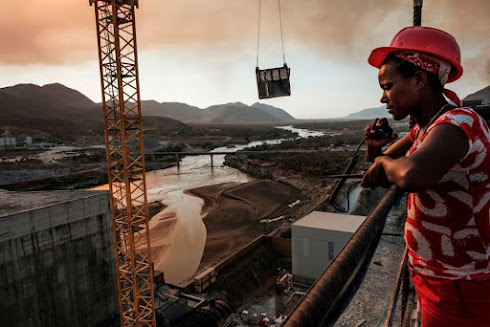An introduction to Nile Basin hydropolitics
Introduction to writing about Africa
‘Africa’ is often
wrongly thought of as a singular entity, particularly among popular culture
development discourse. In the West we rarely consider other continents in
the homogenous manner that Africa is, even Europe is at least split between
East and West. It is crucial to acknowledge the multiplicity of political
discourses across a continent with widely different regions.
There are nuances
within regions themselves. The focus of this blog series will be in East
Africa, specifically the Nile Basin and its complex hydro-politics. The Nile is
the longest river in the world, with its basin spanning 3,349,000 square
kilometres of East Africa. 487.3 million live in 11 countries of the basin. North
to South each nation along the river is unique as the climate evolves from the
Ethiopian highlands, the grasslands of South Sudan and the deserts of Egypt.
Setting the scene in East Africa
Regions across the African continent all have different hydro-political issues; the vast Nile Basin is presented with one of Africa’s most contentious but also opportunistic. The politics of a water infrastructure and how it can highlight the interdependencies between natural, engineered, and economic systems in an entire region are stark and the Grand Ethiopian Renaissance Dam (GERD) is not exception. The £3billion dam is aiming to address Ethiopia’s power deficit, where 65% of Ethiopians are not connected to the national grid, generating up to 6000MW of clean electricity once fully operational. Opportunities also exist for neighbouring countries such as Sudan and the DRC who can tap into this electricity supply and have more predictable river flows throughout the year, vital for crop irrigation.
However, the serious potential changes to the water course that supplies downstream nations, specifically Sudan and Egypt, have characterised the region as one of potential conflict. Initially on board with the project as it would address its own energy needs and allow for more predictable river flow during the extreme wet and dry seasons, improving irrigation water supply reliability, Sudan suffered water shortages as four of the dam's outlets were shut off in 2020. Now, they are concerned about their future water security.
Arid Egypt from the outset has been against the project, relying on the Nile for 95% of its water supply. Egypt feels the GERD upsets the balance of power in the region and might mean increase instances of water scarcity like those seen in Sudan. Egypt is not a member of the Nile Basin Initiative (NBI), the current institutional mechanism for regional cooperation and thus it has been difficult for Ethiopia to initially cooperate.
These instances do not negate the fantastic opportunities for regional cooperation, particularly new avenues for bilateral and trilateral cooperation in the region, however it would be naïve to deny the opportunities for conflict, particularly as commentators have been speculating about the prospect of a ‘water war’. Despite ongoing talks since 2011, no official agreement has been reached. Agreement involves at least 3 countries, plus other state and non-state stakeholders across the Nile basin and existing colonial-era legal mechanisms currently in place are dated.
So we can see how one water infrastructure project can have a significant impact upon the hydropolitics of an entire river basin, with both opportunities and challenges for cooperation. It should be noted water scarcity is not always controlled by the presence or absence of physical flowing water. This blog series will take several weeks to explore the nuances of hydropolitics and water scarcity in the Nile Basin region.





Hi! I really enjoyed your introduction post. I think that using the Grand Ethiopian Renaissance Dam as an entry point is a very good idea, since it is such an interesting and complex topic. My question is: how did this dam get financed? Did they get any help? I am looking forward to reading your answer and the next blog post!
ReplyDeleteHello! Thank you for your comment, I hope the series has gone some way to understanding some of the nuances behind the GERD discourse. The dam was entirely self-funded by Ethiopia through taxes and bonds, meaning there is an emotional tie with the dam. The hashtag #itsmydam has become popular in Ethiopia as a way of signifying its rise.
DeleteThis is a nice introduction with good engagement with literatures and well presented. What is the implicaiton of GERD on Sudan?
ReplyDeleteThank you! On the surface Sudan stands to gain from GERD. This is both from HEP addressing the nation's significant energy deficits and expansion of agriculture from more uniform release of water during the dry season. However in 2020 the shutting off of outlet valves drastically reduced water flow and agriculture suffered, so Sudan's worries have become similar to those of Egypt in regard to Ethiopia's control over the flow of the Blue Nile. A 2019 paper by Ayana and Srinivasan (https://doi.org/10.1016/B978-0-12-815998-9.00012-9) details this further.
Delete